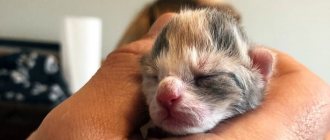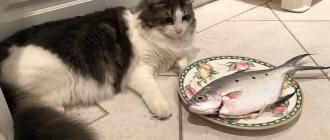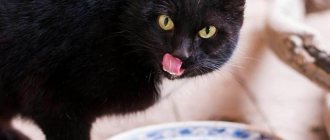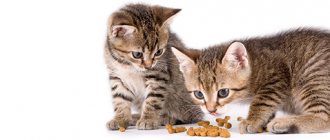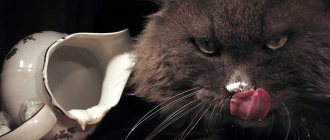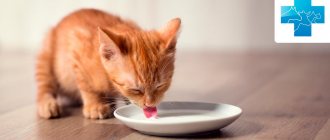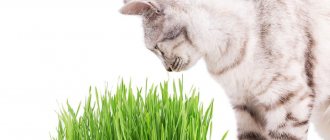Cheese is rich in microelements that have a beneficial effect on any organism, however, when including the product in the diet of pets, you must be extremely careful. Cheese can be both beneficial and harmful, so it is important to find out whether cats can have cheese, which varieties are best to use and in what quantity to give it to the animal.
What kind of cheese can you give your cat?
Cheese is produced from milk with the help of coagulating enzymes, various bacteria and mold.
Therefore, if a cat has lactose intolerance, then it will not be able to eat this food. However, due to the way they are processed, cheese products are easier to digest than milk. The nutritional value
They contain a lot of proteins (up to 25%), polyunsaturated fatty acids (up to 60%) and microelements (up to 3.5%), especially calcium and phosphorus. In addition, the product contains substances that stimulate appetite and stimulate the release of digestive enzymes. Cheese contains a large amount of vitamins A, B1, B2, B5, B12, C, D, E, PP. Its composition is similar to milk and includes valuable substances in the same proportions.
Because of this, cheese in general can be given to a cat, as well as fermented milk products (cottage cheese and kefir). However, this product contains too much fat (on average 40-50%), so it can only be used as a treat, and not as the main component of the daily diet.
Lactose intolerance
Among cats, it is quite rare to find individuals who suffer from complete lactose intolerance. However, pathology in these animals cannot be completely excluded. Therefore, it is advisable for the owner to check whether the pet has such a pathological feature, and for this you can conduct a simple test:
- The animal should be given some dairy or fermented milk product, such as milk, kefir or cheese.
- During the first 24 hours, it is recommended to monitor the pet’s condition to see if it exhibits one or more symptoms of an allergic reaction: diarrhea (loose, watery stools), bloating, flatulence, nausea, vomiting, pain in the abdominal area. You should look into your pet's tray; it should not become more dirty than usual.
If there are no such signs, the cat behaves as usual and its condition has not changed, which means that the digestive system copes well with fermented milk products and has the enzymes necessary for processing lactose. In this case, the cat can be periodically pampered with sour milk, including a small slice of cheese.
Classification
There are many types of cheeses based on the method of preparation:
- Fermented milk products . They are obtained from skim milk, which is subjected to the action of lactic acid culture. They often add cottage cheese, sour cream, salt, and butter. Spices may include cocoa, onions, coffee, chocolate and vanillin. Cheeses without additives (with cottage cheese or milk) are allowed to be given to cats, but all others are not allowed, since spices often cause allergies and poisoning.
- Serum . It is made from whey, which is formed after the cheese-making procedure (that is, from recycled materials). Because of this, they contain a lot of albumin and relatively little fat - 15-25%. The best option for a cat would be Adyghe cheese due to its quality, lack of spices, dangerous additives and low price. This product is rich in vitamins and microelements; most of them contain 15-25% of the animal’s total daily requirement for these substances in 100 grams.
- Molds . These are cheeses that have been exposed to various molds, most often from the genus Penicillium. Their fat content is average - 25-35%, no spices or additives are added, since the taste is already good due to the action of mold. For these reasons, moldy cheeses can be fed to cats, but the first time you should give them a little, as an allergic reaction to the fungi is possible.
- Smoked . In the Russian Federation, the most common are suluguni and sausage cheese. Smoking imparts a special taste due to processing at high temperatures. After this, the cheese is dehydrated, saturated with bacteriostatic, preservative substances and carcinogenic polycyclic hydrocarbons. This product should not be given to cats due to the high content of salts and preservatives.
- Rennets . Produced from milk under the action of rennet - rennin. All of them have a fairly high fat content - 40-50%, which is why they should not be given to pets often. Among rennet, only hard and soft cheeses are suitable for feeding cats. Brine products should not be given to animals due to the large amount of salt and spices in the composition.
| Name | Fat | Can? | Why? |
| Parmesan | 32% | Yes | Does not contain spices, has a lot of proteins, vitamins, calcium |
| Swiss | 50% | Carefully | Includes a lot of salt (1.5-2.5%), but no other spices |
| Dutch | 45% | No | Due to excessive sharpness |
| Cheddar | 50% | Yes | Doesn't have much spice or salt |
| Roquefort | 45% | Carefully | Possible allergic reaction to mold |
| Camembert | 60% | A little | Due to its high fat content, it can be given, but in small quantities. |
| Brine | 20% | No | Due to high salt content - 7% |
| Adyghe | 16% | Yes | Includes many vitamins, amino acids, microelements |
| Schabziger | 20% | No | Due to the addition of spices |
| Khartssky | 1% | No | Due to the addition of spices |
| Fused | 50% | No | Since it contains a lot of salt and spices |
| Ricotta | 25% | Yes | Includes albumin and lactose |
| Brunust | 20% | Yes | Has a lot of proteins, vitamins, lactose |
| Blue | 30% | Carefully | Possible allergic reaction to mold |
Raw meat
You can feed your cat raw meat, but you need to keep in mind the pros and cons of such food.
There is no doubt that in the wild animals eat raw meat and feeding a cat such meat is more natural. It is worth noting that during heat treatment, meat loses a significant part of its nutrients, aroma and juiciness. However, there are also disadvantages to feeding your cat raw meat. The main disadvantage is dangerous infections that can cause significant harm to the health of the animal. A helminthic infestation is also possible when feeding a cat raw meat.
If you are confident in the safety of raw meat that you want to pamper your cat with, then you should give the animal only lean veal, beef, lamb and poultry. Fatty meat and pork should not be given.
What kind of cheese should you not feed your cat?
A cat will not eat cheese if it is harmful to it. At the same time, she can beg for it, since the smell and taste are sometimes very different. Because of this, it is impossible to know how appetizing a product is by its aroma. A pet may ask for foods that are inedible for it, but in most cases it will not eat them.
Smoked cheeses should be completely excluded from the diet, as they may contain dangerous carcinogens. In addition, modern smoking occurs not so much due to temperature, but due to the action of chemicals that are added to the starter to speed up the process. Such products are harmful to the liver and kidneys.
In addition, some manufacturers replace milk fats with vegetable fats. Firstly, this makes the product cheaper, and secondly, it increases its shelf life. However, such fats do not have such high nutritional value and cause great harm to the liver. In addition, some cheeses contain preservatives, dyes and stabilizers that can cause an allergic reaction.
In general, it is necessary to exclude products containing:
- powdered milk;
- stabilizers;
- soy;
- flavoring additives;
- dyes;
- vegetable oil;
- preservatives.
Lactose allergy test
You cannot feed a cat, especially a kitten, cheese at its first request. Before consuming a certain (low-fat) type of product for the first time, you need to find out or remember how the animal’s body reacts to lactose. This substance is included in any dairy product. If a cat develops indigestion - diarrhea - after eating this product, it is likely that this process will occur after feeding it cheese.
© shutterstock
Some animals cannot enjoy milk without “consequences,” but tolerate fermented milk products well. In this case, you can try using cheese to feed them. It should be introduced into the diet carefully, starting with a very small piece; you cannot immediately offer a large portion.
Cheese components can act as an allergen on the cat's body. Frequent manifestations of such reactions are problems with the animal’s skin; its hair may fall out significantly. If such signs appear, your pet’s diet should be adjusted.
Why cheese can be dangerous
Cheeses can be dangerous for many reasons. The greatest harm comes from salt, fat and spices:
- Cheeses contain a lot of salt - 1.5-2.5% of the total weight, sometimes up to 7%. Cats are predisposed to urolithiasis, which is caused by narrow and tortuous urinary tracts. They must exclude salt from their diet, and cheese contains it in increased quantities.
- The amount of fat reaches 60-70% . Such an unnaturally large amount of fatty acids does not occur in nature, so the liver and pancreas of cats are not adapted to digest such products. Why cheeses can cause digestive upset.
- Spices and various additives are added to many cheeses . At best, they will be of plant origin (cumin and others). But in most situations these include chemical antioxidants, thickeners, preservatives, dyes, emulsifiers and other substances. All these compounds can cause an allergic reaction.
Peculiarities of cheese consumption by castrated animals
The castration procedure changes the lifestyle of cats and female cats. They become more docile, passive, and at the same time, owners note an increase in the appetite of their pets. But with increased gluttony, the digestive system works worse and worse. This leads to disruptions in the functioning of internal organs, in particular to the development of urolithiasis and obesity.
A castrated cat can have cheese, but only in controlled quantities. The varieties should be the least caloric and low-fat.
How to keep cheese safe
It is impossible to make cheese safe without decomposing it into a tasteless paste. Cooking or freezing is aimed at destroying bacteria, which do not pose a danger in these products. Mold is present, but it causes problems in the form of allergic reactions in only too few animals. Much more often, lactose is the cause of problems.
Cheese is dangerous due to a large amount of fat, spices and salt, which are not destroyed when cooled. The damaging effect of freezing is based on the expansion of water, which ruptures microorganisms as it turns into ice. However, there is too little water in cheeses, and most products do not contain any bacteria.
Prolonged cooking can decompose fats, but this will only happen along with the destruction of all vitamins and proteins, which reduces the nutritional value of the product. As a result of prolonged cooking in cheese, most of its elements are destroyed, which is why it loses its shape and taste.
Cheese is given exclusively in its raw form; it cannot be cooked. This product is also not prepared in any way. At one time, you can give your pet a small cube no larger than a centimeter in size. Cheese is used as a treat, that is, it is added to the animal’s diet no more than once a week. You can feed it to adult pets and kittens older than six months. Before giving it for the first time, you need to make sure that the cat is not allergic to lactose (give her a little milk).
Cheese-related products
Having heard the term, a person imagines a yellow dense piece with holes. But cheese is called different products. In English the word additionally means:
Cats like all these dishes. Breed does not affect preference. Elite pets and yard dwellers show interest in cheeses. Animals can literally snatch a milk-coated sandwich from a person. The decision to share with your pet depends on the composition of the product.
Potentially Hazardous Components
Cats and people perceive biological substances differently. Onions (tuber and stems) and garlic are dangerous foods that can cause the breakdown of red blood cells. Not found in regular cheeses, they are potential additives for brushes, processed foods, and pet-attracting flavorings.
Other potentially hazardous ingredients include:
- Mold – you should not give elite cheese to cats. Microorganisms can disrupt the bacterial balance of the intestines. A product that has become more expensive in the refrigerator should not be eaten by the animal or its owner.
Dyes. Stores offer colorful cheeses, colored by natural additives: tomatoes, lavender, herbs. Natural and synthetic pigments are potentially dangerous for cats. Natural dyes will provide a rich shade due to their high concentration. Spices and nightshades (tomatoes) are potential toxins for cats. Synthetic pigments tend to accumulate in the body, affecting the functions of internal organs.
Flavorings, taste enhancers. They are addictive, can cause allergies and other unpleasant consequences.
Homemade dairy products pose additional risks. Raw cottage cheese (cheese cheese) may contain pathogens, manufacturer. Having caused indigestion in a person, it can cause serious poisoning and damage to internal organs in a pet.
